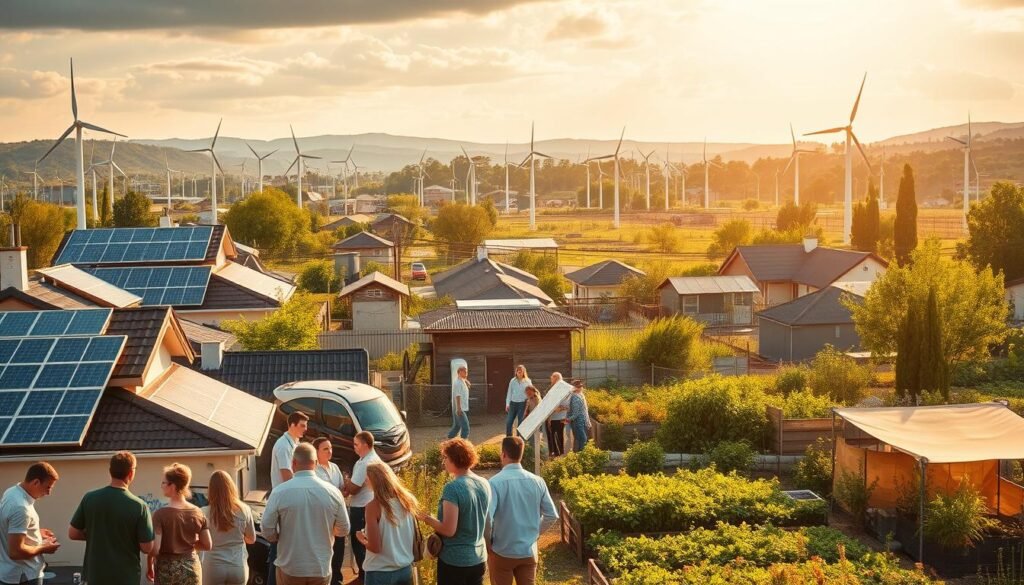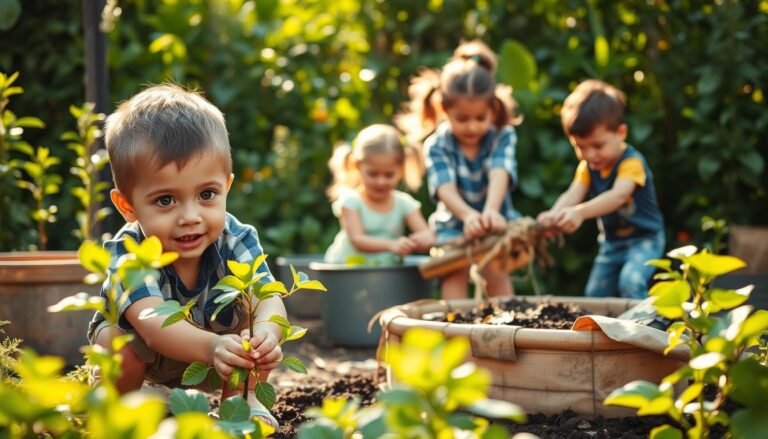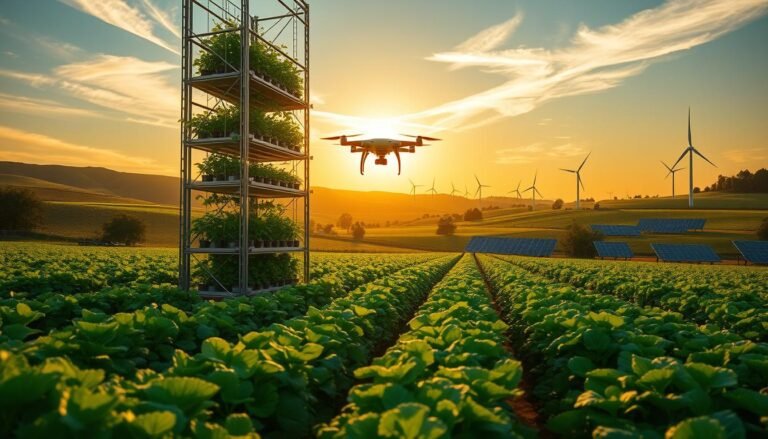Embracing sustainability has become a vital aspect of modern living, and the circular economy is at the forefront of this movement.
The concept focuses on minimising waste and maximising resource use by keeping products, materials, and resources in circulation for as long as possible. This approach is particularly significant in local communities, where it can have a profound impact on the environment and the economy.
By adopting local sustainability practices, communities can reduce their ecological footprint and foster a more resilient economy.
Key Takeaways
- Understanding the circular economy and its benefits
- The role of local communities in adopting sustainable practices
- Reducing waste and maximising resource use
- Fostering a resilient economy through local sustainability
- Embracing a circular economy for a better future
Understanding the Circular Economy Model
The circular economy model is about rethinking the way we use resources to minimize environmental impact. It’s a significant departure from the traditional linear economy, which is based on a take-make-dispose approach.
From Linear to Circular: A Paradigm Shift
The traditional linear economy has been the backbone of industrial development for centuries. However, this model is no longer sustainable due to its significant environmental costs.
The Take-Make-Dispose Problem
The take-make-dispose approach is inherently wasteful. It involves extracting resources, manufacturing products, and then discarding them after use. This results in substantial waste and environmental degradation.
Key issues with the linear economy include:
- Overconsumption of natural resources
- Generation of significant waste
- Environmental pollution
Regenerative Design Principles
In contrast, the circular economy promotes regenerative design principles that encourage the continual use of resources. This involves designing products and systems that are restorative and regenerative by design.
Some key strategies include:
- Designing for recyclability and reuse
- Using renewable energy sources
- Promoting sharing and collaboration
By adopting these strategies, communities can significantly reduce waste and environmental impact. The circular economy model is not just an economic strategy; it’s a pathway to a more sustainable future.
The Australian Context: Why Circular Economy Matters Locally
As Australia confronts its environmental challenges, the adoption of circular economy practices is emerging as a critical strategy for local sustainability. The country’s waste management issues are significant, with high landfill rates and the recent impact of export bans on waste materials.
Australia’s Waste Challenge
Australia faces a substantial waste challenge, with a significant portion of its waste ending up in landfills. This not only results in the loss of valuable materials but also contributes to environmental degradation.
Current Landfill Statistics
Australia’s landfill statistics are alarming, with millions of tons of waste being sent to landfills each year. The table below highlights the current state of waste management in Australia.
| Year | Waste to Landfill (tons) | Recycling Rate (%) |
|---|---|---|
| 2018 | 20 million | 30% |
| 2020 | 22 million | 32% |
| 2022 | 24 million | 35% |
The Export Ban Impact
The export ban on waste materials has significantly impacted Australia’s waste management landscape. With the ban, Australia can no longer export its waste to other countries, forcing the need for more effective local waste management strategies.
This shift has led to an increased focus on recycling and reusing materials, aligning with the principles of the circular economy. Communities are now more inclined to adopt practices that reduce waste and promote sustainability.
By embracing the circular economy, Australia can address its waste challenges while promoting local sustainability and reducing its environmental footprint.
Circular Economy Examples in Local Communities
Local communities across Australia are embracing the circular economy by implementing innovative waste reduction programs. These community-led initiatives are crucial in reducing waste and promoting sustainable practices.
Community-Led Waste Reduction Programs
Various communities are taking proactive steps to minimize their environmental footprint. For instance, some towns are adopting zero-waste policies, aiming to eliminate waste sent to landfills.
Zero Waste Towns Initiative
The Zero Waste Towns Initiative is a notable example, where communities strive to reduce, reuse, and recycle waste effectively. This initiative involves community education programs, workshops, and collaborations with local businesses to minimize waste.
Plastic-Free Community Campaigns
Another significant effort is the Plastic-Free Community Campaigns, which aim to reduce plastic use in local communities. These campaigns promote the use of reusable products and encourage local businesses to adopt sustainable packaging.
For more information on circular economy practices in cities, you can refer to the European Union’s circular cities report, which provides valuable insights into successful strategies and initiatives.
| Initiative | Description | Impact |
|---|---|---|
| Zero Waste Towns | Community-led waste reduction | Significant reduction in landfill waste |
| Plastic-Free Campaigns | Reducing plastic use | Decrease in plastic waste in local environments |
These community-led initiatives not only contribute to a cleaner environment but also foster a sense of community and cooperation. By reusing and reducing waste, local communities are making significant strides towards a more circular economy.
Food Systems and Circular Solutions
Local food systems are embracing circular economy principles to enhance sustainability. This shift is crucial in reducing waste and promoting local food production. Community gardens and urban farming initiatives are at the forefront of this movement, providing numerous benefits to both the environment and local communities.
Community Gardens and Local Food Production
Community gardens play a vital role in local food production by providing green spaces where individuals can grow their own fruits and vegetables. These gardens not only promote sustainable food production but also foster community engagement and education on sustainable practices.
Urban Farming Initiatives
Urban farming initiatives are another example of circular solutions in food systems. These initiatives involve growing, processing, and distributing food in urban areas, reducing the carbon footprint associated with transportation and enhancing food security.
Benefits of Urban Farming:
- Increased food security
- Reduced transportation emissions
- Enhanced community engagement
- Improved access to fresh produce
Seed Saving Networks
Seed saving networks are crucial for maintaining biodiversity and promoting sustainable agriculture practices. By saving and exchanging seeds, community members can preserve heritage crop varieties and develop resilience in their food systems.
A notable example of a successful circular economy initiative is the community garden in Marrickville, New South Wales. This garden not only provides a space for local residents to grow their own food but also serves as an educational hub for sustainable gardening practices.
| Initiative | Location | Benefits |
|---|---|---|
| Community Garden | Marrickville, NSW | Sustainable food production, community engagement |
| Urban Farming | Various Australian cities | Food security, reduced emissions |
| Seed Saving Network | National | Biodiversity preservation, sustainable agriculture |
These examples demonstrate the potential of circular economy principles in transforming local food systems. By adopting sustainable practices and promoting community engagement, we can create more resilient and environmentally friendly food production systems.
Circular Water Management in Australian Towns
Water scarcity is a significant challenge in many Australian towns, making circular water management practices crucial for sustainability. As the country faces increasing pressures on its water resources, adopting a circular economy approach to water management is becoming essential.
Water Recycling Systems
Water recycling systems are a vital component of circular water management. These systems treat and reuse water for various purposes, reducing the demand on potable water supplies. Advanced water treatment technologies enable the recycling of water for irrigation, industrial processes, and even drinking water in some cases.
Blackwater Treatment Innovations
Innovations in blackwater treatment are playing a significant role in enhancing water recycling capabilities. Blackwater, which includes wastewater from toilets and kitchens, requires sophisticated treatment to make it safe for reuse. Membrane bioreactor technology is one such innovation that is being used to treat blackwater effectively.
Fit-for-Purpose Water Solutions
Fit-for-purpose water solutions involve using water of a quality appropriate for its intended use, rather than always relying on potable water. For example, recycled water can be used for agricultural irrigation, reducing the strain on drinking water supplies. This approach not only conserves water but also reduces the energy required to treat water to drinking standards.
Implementing circular water management practices in Australian towns involves a combination of technological innovation, community engagement, and policy support. By adopting these practices, towns can enhance their water security, reduce environmental impacts, and move towards a more sustainable future.
- Water recycling reduces the demand on potable water supplies.
- Fit-for-purpose water solutions conserve water and reduce energy consumption.
- Innovative technologies like membrane bioreactors enhance blackwater treatment.
Circular Construction and Housing Projects
In the pursuit of local sustainability, circular economy case studies in construction are gaining momentum. The construction industry is one of the largest consumers of resources and generators of waste, making it a critical sector for the application of circular economy principles.
Building with Recycled Materials
The use of recycled materials in construction is a growing trend in circular construction. This approach not only reduces waste but also conserves natural resources. Recycled materials can be used in various aspects of building construction, from foundations to finishes.
Recycled Concrete Aggregates
Recycled concrete aggregates (RCA) are a prime example of building with recycled materials. RCA is produced by crushing concrete waste and reusing it as aggregate in new concrete. This process reduces the need for virgin aggregates and decreases the environmental impact of concrete production.
Repurposed Timber Applications
Repurposed timber is another valuable resource in circular construction. Salvaged wood from demolished buildings can be reused in new constructions, adding character and reducing the demand for new timber. Repurposed timber can be used for structural elements, flooring, and decorative features.

| Material | Traditional Use | Circular Economy Application |
|---|---|---|
| Concrete | Building foundations, walls | Recycled Concrete Aggregates (RCA) for new concrete |
| Timber | Structural framing, flooring | Repurposed timber for decorative and structural elements |
The adoption of circular economy principles in construction not only contributes to local sustainability but also offers economic benefits through reduced material costs and waste disposal savings. As the industry continues to evolve, we can expect to see more innovative applications of recycled materials in construction projects.
Local Manufacturing and Repair Economies
Australian communities are embracing local manufacturing and repair economies to reduce waste and promote sustainability. This shift is crucial in the transition towards a circular economy, where resources are utilized efficiently, and waste is minimized.
Repair Cafés and Fix-it Clinics
Repair cafes and fix-it clinics are community-driven initiatives that promote the repair and reuse of products, reducing waste. These initiatives not only help in reducing the environmental footprint but also foster community engagement and skill sharing.
Volunteer-Run Repair Events
Volunteer-run repair events are a hallmark of repair cafes and fix-it clinics. These events bring together volunteers with repair skills and individuals looking to fix their belongings. It’s a collaborative effort that extends the life of products, reducing the need for new, resource-intensive items.
Skill-Sharing Workshops
Skill-sharing workshops are another critical component, where experts share their knowledge on repairing various items, from electronics to furniture. These workshops empower community members with the skills to repair their belongings, further embedding the culture of reuse and reduce.
By supporting local manufacturing and repair economies, communities can create a more sustainable and resilient local economy. It’s a step towards closing the loop and achieving a circular economy where resources are valued and waste is a thing of the past.
Textile and Fashion Circularity
The fashion industry is one of the largest polluters globally, making textile circularity crucial for local sustainability. As consumers become more aware of the environmental impact of their purchasing decisions, community-led initiatives are emerging to promote a more circular approach to fashion.
Community Clothing Swaps and Libraries
Community clothing swaps and libraries are innovative approaches to reducing textile waste. These initiatives not only reduce the amount of waste sent to landfills but also foster a sense of community and promote sustainable fashion practices.
Neighbourhood Exchange Events
Neighbourhood exchange events, such as clothing swaps, are becoming increasingly popular. These events allow individuals to exchange gently used clothing, reducing the need for new purchases and keeping existing garments in circulation.
Subscription-Based Clothing Libraries
Subscription-based clothing libraries offer another avenue for promoting textile circularity. For a monthly fee, members can access a wide range of clothing items, returning them after use to be worn by others. This model encourages the sharing economy and reduces the demand for fast fashion.
These community-driven initiatives serve as a valuable circular economy case study, demonstrating how local actions can contribute to broader sustainability goals. By adopting such practices, communities can make a significant impact on reducing textile waste and promoting a more circular fashion industry.
Energy Circularity in Communities
The shift towards energy circularity in local communities is gaining momentum, driven by innovative projects that prioritize renewable energy and reduce waste. This movement is crucial in Australia, where communities are increasingly taking control of their energy futures through community-owned renewable energy initiatives.
Community-Owned Renewable Energy
Community-owned renewable energy projects are a cornerstone of energy circularity, enabling local residents to invest in and benefit from renewable energy generation. These projects not only reduce reliance on non-renewable energy sources but also foster community engagement and cooperation.
Solar Gardens and Shared Ownership
Solar gardens and shared ownership models are becoming increasingly popular, allowing multiple individuals or organizations to invest in a single solar array. This approach makes renewable energy more accessible to a wider range of community members, promoting energy circularity and reducing carbon footprints.
Microgrids and Energy Trading
Microgrids and energy trading platforms are another key aspect of energy circularity, enabling communities to generate, store, and trade energy locally. This not only enhances energy resilience but also provides economic benefits to community members involved in energy trading.
Some of the key benefits of energy circularity in communities include:
- Reduced reliance on non-renewable energy sources
- Increased community engagement and cooperation
- Improved energy resilience through microgrids and local energy trading
- Economic benefits for community members through energy trading and shared ownership models
By embracing energy circularity, Australian communities can make significant strides towards a more sustainable and renewable energy future. As the demand for clean energy continues to grow, community-owned renewable energy initiatives are poised to play a vital role in shaping the country’s energy landscape.

Case Study: Circular Economy Success Stories in Australian Communities
Byron Bay’s zero-waste movement is a shining example of how Australian communities can adopt circular economy principles effectively. This coastal town has become a hub for sustainability initiatives, demonstrating that even small communities can make a significant impact.
Byron Bay’s Zero Waste Movement
The Byron Bay community has come together to reduce waste through various initiatives, including clean-up events, recycling programs, and education campaigns. The town’s zero-waste movement is driven by a strong sense of community and a shared commitment to sustainability.
Business Engagement Strategies
Local businesses have played a crucial role in Byron Bay’s zero-waste movement. Many have adopted sustainable practices, such as reducing single-use plastics and implementing recycling programs. For example, some cafes have switched to compostable packaging, while others have eliminated plastic straws altogether.
“We’ve seen a significant shift in consumer behavior, with more people seeking out businesses that prioritize sustainability,” said a local business owner. “It’s not just good for the environment; it’s also good for business.”
Tourism Sector Innovations
The tourism sector in Byron Bay has also been a driving force behind the town’s sustainability initiatives. Many tourism operators have implemented environmentally friendly practices, such as reducing energy consumption and promoting eco-friendly activities.
| Initiative | Description | Impact |
|---|---|---|
| Beach Clean-Ups | Regular clean-up events organized by local community groups | Reduced marine pollution and raised awareness about waste management |
| Eco-Tourism Programs | Tourism operators promoting environmentally friendly activities | Increased adoption of sustainable tourism practices and reduced carbon footprint |
| Recycling Initiatives | Implementation of recycling programs in local businesses and households | Significant reduction in waste sent to landfills |
Byron Bay’s success story demonstrates that with community engagement, business support, and innovative strategies, Australian communities can achieve significant sustainability goals.
Implementing Circular Economy Principles in Your Community
The journey to a circular economy begins at home, with conscious choices and actions. Individuals and households play a crucial role in reducing waste and promoting sustainability in their local communities.
Starting Small: Individual and Household Actions
Every small action counts when it comes to embracing the circular economy. By making a few simple changes to daily habits, individuals can significantly reduce their environmental footprint.
Daily Practices for Waste Reduction
Reducing waste starts with being mindful of daily consumption. Simple practices include:
- Using reusable bags and containers for shopping
- Avoiding single-use plastics
- Composting food waste
- Repairing items instead of throwing them away
These actions not only reduce waste but also contribute to a culture of sustainability within the community.
Consumption Choices and Impact
The choices we make as consumers have a significant impact on the environment. Opting for products with minimal packaging, buying second-hand, and supporting local businesses are effective ways to reuse and reduce waste.
| Action | Impact |
|---|---|
| Using reusable bags | Reduces plastic waste |
| Buying second-hand | Decreases demand for new, resource-intensive products |
| Supporting local businesses | Boosts local economy and reduces transportation emissions |
By making informed choices, individuals can drive demand for more sustainable products and services, contributing to a circular economy.
As more individuals and households adopt circular economy principles, the collective impact can lead to significant positive change in local communities.
Overcoming Barriers to Local Circular Economies
The transition to a circular economy in local communities is often obstructed by existing regulatory frameworks. These barriers can hinder the development of sustainable practices and limit the potential for local sustainability.
Addressing Regulatory Challenges
Regulatory challenges are a significant obstacle to implementing circular economy practices. These challenges include planning restrictions and health and safety considerations.
Navigating Planning Restrictions
Planning restrictions can limit the redevelopment of sites for circular economy projects. For instance, zoning laws may prohibit the establishment of community gardens or recycling facilities in certain areas. To overcome these restrictions, local governments can revise their zoning laws to accommodate circular economy initiatives.
Health and Safety Considerations
Health and safety regulations are crucial for protecting the well-being of community members. However, these regulations can sometimes be overly restrictive, hindering the development of circular economy projects. For example, regulations regarding waste handling and recycling can be stringent, requiring specialized equipment and training.
| Regulatory Challenge | Impact on Circular Economy | Potential Solution |
|---|---|---|
| Planning Restrictions | Limit redevelopment of sites | Revise zoning laws |
| Health and Safety Regulations | Restrict waste handling and recycling | Provide specialized training and equipment |
By understanding and addressing these regulatory challenges, local communities can better implement circular economy practices, enhancing local sustainability. A circular economy case study in a local community can provide valuable insights into effective strategies for overcoming these barriers.
In conclusion, overcoming regulatory barriers is crucial for the successful implementation of circular economy practices in local communities. By revising zoning laws, providing specialized training, and adopting flexible health and safety regulations, communities can foster a more sustainable and circular economy.
Measuring Success: Indicators for Circular Community Initiatives
Assessing the effectiveness of circular economy initiatives in local communities requires a nuanced understanding of environmental impact metrics. These metrics are crucial for evaluating the success of projects aimed at reducing waste and promoting sustainability.
Environmental Impact Metrics
Environmental impact metrics provide a quantifiable measure of the effects of circular economy initiatives on the environment. By tracking these metrics, communities can identify areas of improvement and adjust their strategies accordingly.
Waste Diversion Rates
One key metric is the waste diversion rate, which measures the percentage of waste that is diverted from landfills through recycling, composting, or reuse. For instance, a community that implements a successful recycling program can significantly reduce its waste diversion rate, thereby decreasing its environmental footprint.
Carbon Footprint Reduction
Another important metric is carbon footprint reduction, which quantifies the decrease in greenhouse gas emissions resulting from circular economy initiatives. By adopting practices such as energy-efficient technologies and renewable energy sources, communities can substantially reduce their carbon footprint.
By focusing on these environmental impact metrics, communities can gain a clearer understanding of the effectiveness of their circular economy initiatives and make data-driven decisions to enhance their sustainability efforts. This, in turn, supports the broader goal of promoting reuse and reduce practices within local communities.
Conclusion: The Future of Circular Economies in Australian Communities
The adoption of circular economy practices is crucial for the future sustainability of Australian communities. As discussed, various local communities are already implementing innovative circular economy solutions, from community-led waste reduction programs to circular water management systems.
These local sustainability initiatives not only reduce waste and environmental impact but also foster community engagement and economic resilience. Examining circular economy case study examples across Australia provides valuable insights into effective strategies for closing the loop and achieving a more sustainable future.
By continuing to innovate and adopt circular practices, Australian communities can lead the way in environmental stewardship and create a more sustainable and equitable future for all.





